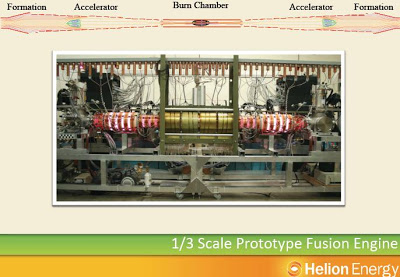Helion Energy has built a one third scale fusion generator and wants $20 million to build a full scale prototype by 2011. They would need another $100 million or so to build a first commercial version by 2019. Successful development of commercial nuclear fusion should revolutionize space travel, energy production and provide massive economic benefits when fully deployed.
UPDATE In 2013, Helion Energy reported having received a total of about $7 million in funds from DOE, the Department of Defense and NASA. The company hopes to raise another $2 million by next year, $35 million in 2015-17, and $200 million for its pilot plant stage. Helion Energy’s new plan is to build a 50-MWe pilot of its “Fusion Engine” by 2019 after which licensees will begin building commercial models by 2022.
Helion Energy has the exclusive license to a novel energy technology, the Fusion Engine. A prototype at 1/3 commercial scale is operational and generating energy from fusion. The Fusion Engine works by forming hot, ionized deuterium and tritium gas known as a Field Reversed Configuration plasma. Two of these plasmas are then electromagnetically accelerated to greater than 1 million mph and then collided in a burn chamber. In this isolated region, temperatures reach 50 million degrees and release enormous amounts of energy.
Note: Field reversed configuration plasma using colliding beams is the technology being developed by the secretive Tri-Alpha Energy which has raised over $40 million.
The $20 million would enable building a full‐scale prototype.
– Energy generation is volumetric therefore scale increase required for breakeven
• Development of Repetitive Pulse Technology
– Continuous operation requires repeated fusion events to meet commercial targets
• Continued/Additional Computer Modeling of Commercial Reactor
– Optimize for high efficiency power generation
UPDATE:
Follow up article on this site about using this type of fusion for space propulsion.
(H/T to Kurt9) Talk Polywell discussion
Quotes from Art Carlson:
The idea itself is old, so the question is how they deal with the known difficulties. One of these is that FRCs, when scaled to reactor sizes, are supposed to be unstable. (Actually they are supposed to be unstable at laboratory size, which they are not, but it will probably get worse when scaling up.)
The topology of an FRC machine is linear, so it is much simpler than a (toroidal) tokamak, and it operates naturally at high beta, so the power density is 2 orders of magnitude higher than for a tokamak.
the Seattle area code of the CEO matches the UW, so there is probably more than a coincidental relationship here. That’s good. John Slough is an old buddy of mine. He was running the experiment I did my Ph.D. work on. Definitely serious. Keep your eye on this one (but watch your pocketbook).
There are a lot of interesting things to say about this concept. For example, direct conversion: You can magnetically compress the configuration till it starts burning, then let it expand against the field. If you are lucky, you get more electrical energy out than you put in to begin with. This is the most attractive direct conversion scheme I know of. Another thing, wall loading: Since this thing is zipping down a tube, it you decide the heat and/or neutron flux to the wall is too large at your design point, you can simply make your tube a bit longer and send the plasma down it a bit faster
But, from http://www.physicsessays.com/doc/s2005/John_Slough-Final.pdf:
Most importantly, the FRC remains in a stable regime with regard to MHD modes such as the tilt from formation through burn.
Finally, in the reactor scenario outlined for PHD, the FRC at no time exceeds the empirical regime where stability and good confinement has been observed throughout the entire formation process through burn.
From http://hifweb.lbl.gov/ICC2000/MagnetizedTargetFusion/Slough1_Oral.pdf
Given the observed scaling with size and density, the required radius at a density of 1024 m-3 for a DT fusion burn with a gain > 1 is found to be ~ 1 cm.
The PHD fusion envisioned also provides for a simple direct conversion of the plasma into directed thrust. Of all fusion reactor embodiments, only the magnetically confined plasma in the Field Reversed Configuration (FRC) has the linear geometry, low confining field, and high plasma pressure required for the direct conversion of fusion energy into high specific impulse and thrust, and would thus have direct applicability to deep space flight.

Brian Wang is a Futurist Thought Leader and a popular Science blogger with 1 million readers per month. His blog Nextbigfuture.com is ranked #1 Science News Blog. It covers many disruptive technology and trends including Space, Robotics, Artificial Intelligence, Medicine, Anti-aging Biotechnology, and Nanotechnology.
Known for identifying cutting edge technologies, he is currently a Co-Founder of a startup and fundraiser for high potential early-stage companies. He is the Head of Research for Allocations for deep technology investments and an Angel Investor at Space Angels.
A frequent speaker at corporations, he has been a TEDx speaker, a Singularity University speaker and guest at numerous interviews for radio and podcasts. He is open to public speaking and advising engagements.






